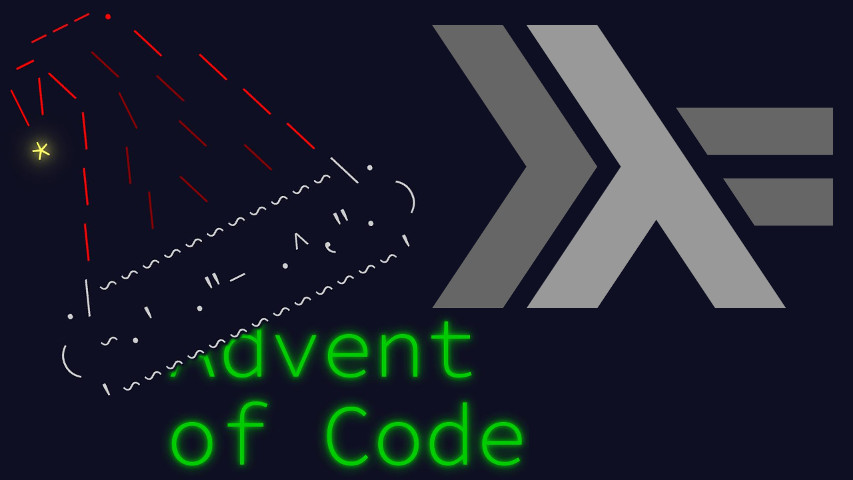Earlier this month Eric Wastl tweeted along the lines of “I love your visualizations, but please include epilepsy warnings when appropriate. He must have had today’s problem, “Trench Map”, in mind at the time. This post is literate Haskell, here are a few imports.
import Control.Arrow ((&&&))
import Data.Array (Array,listArray,(!))
import Data.Set (Set)
import qualified Data.Set as SetThe problem’s core difficulty is handling the infinite surface. As is common for such problems, I’ll represent the image as the set of lit points.
type Pos = (Int,Int)
parse :: String -> (Array Int Bool,Set Pos)
parse (lines -> (p:"":g)) =
( listArray (0,511) (map (== '#') p)
, Set.fromList [ (i,j) | (i,l) <- zip [0..] g, (j,'#') <- zip [0..] l ]
)The points not in the set are thus assumed to be unlit.
But everybody’s problem input comes with a twist: the great void areas not in the set all light up on turn one. So we’ll need to be smarter. We’ll keep the set of pixels idiom, but refine it so that it can alternatively refer to the set of unlit pixels, the other being assumed to be lit. How do we tell them apart? I’ll package in a read-write modifier function, that’ll automatically perform the decoding.
data Picture = Picture
{ picPixels :: !(Set Pos)
, picStep :: !(Array Int Bool)
, picRW :: [Bool -> Bool]
}I store it as a list since all future versions of it can be known from the start. I also package in the transition table. Here’s what the accessors look like:
picRead :: Picture -> Pos -> Bool
picRead Picture{picPixels = pix,picRW = r:_} p = r (Set.member p pix)
picWrite :: Picture -> Bool -> Bool
picWrite Picture{picRW = _ : w : _} v = w vThe only tricky aspect of it is that the flow of the program later on will be to read step N to write step N + 1, so the write modifier is offset.
Now, how do I predict what the modifier function should be? Well, it depends on the transition table. The picture starts as mostly unlit (a finite portion of it is lit), so the read modifier starts as a no-op. What happens after a step? The finite portion may expand a bit, but most of the pixels are the infinite area that started out as zeros. What do those become?
It depends. If bit 0 of the transition table is unset, they remain as zeros, so our representation is stable. If it is one, the infinite section flips on first transition, so the new accessor should be a reversing lens. But what happens on the next transition?
It depends again. If bit 511 of the transition table is set, the infinite area of the picture remains lit, so the representation is actually stable too, just not to the same state as it was given. If it’s unset, the infinity flips again and we’re back in the same situation as the start.
So we can analyze and package a Picture as 3 cases:
analyze :: Array Int Bool -> Set Pos -> Picture
analyze a s = Picture s a $ case (a!0,a!511) of
(False,_) -> repeat id
(True,True) -> id : repeat not
(True,False) -> cycle [id,not]Now the representation is covered, let’s tackle the step function. The modifier is simply shifted to the next one in the list, as set at analysis time. The transition function remains stable, that’s what we introduced the modifier for. The picture remains to be addressed.
The infinite part of it is covered by default: it’s either all zeros or all ones, but it’s not a part of the resulting set. Let’s consider the interesting pixels instead: those that are explicitly referred to.
It’s not enough to consider previously interesting pixels as being interesting for the next iteration: given a neighborhood-based transition matrix, any pixel adjacent to an interesting pixel could become interesting.
So let’s compute the transition boundary for the picture’s representation, found by exploring all adjacent pixels to previously interesting pixels, including themselves.
neighborhood :: Pos -> [Pos]
neighborhood (i,j) = [ (i-1,j-1), (i-1,j), (i-1,j+1)
, (i ,j-1), (i, j), (i, j+1)
, (i+1,j-1), (i+1,j), (i+1,j+1)
]
boundary :: Set Pos -> Set Pos
boundary = Set.unions . Set.map (Set.fromList . neighborhood)The stepping function is then a simple matter of looking up a pixel’s neighborhood in the transition table.
step :: Picture -> Picture
step p = Picture
{ picPixels = Set.fromList
[ (i,j)
| (i,j) <- Set.elems (boundary (picPixels p))
, let bs = map (picRead p) (neighborhood (i,j))
, picWrite p (picStep p ! foldl (\a b -> 2*a + fromEnum b) 0 bs)
]
, picStep = picStep p
, picRW = tail (picRW p)
}A little wrapper can then count interesting pixels after steps 2 and 50. Note that I don’t need to wonder whether the statement asks for lit or unlit pixels: if it wants an answer, it’s got to be the finite set, whichever it is at the moment.
main :: IO ()
main = interact $
show . ((!! 2) &&& (!! 50)) . map (Set.size . picPixels) .
iterate step . uncurry analyze . parse This concludes today’s solution. See you tomorrow!



